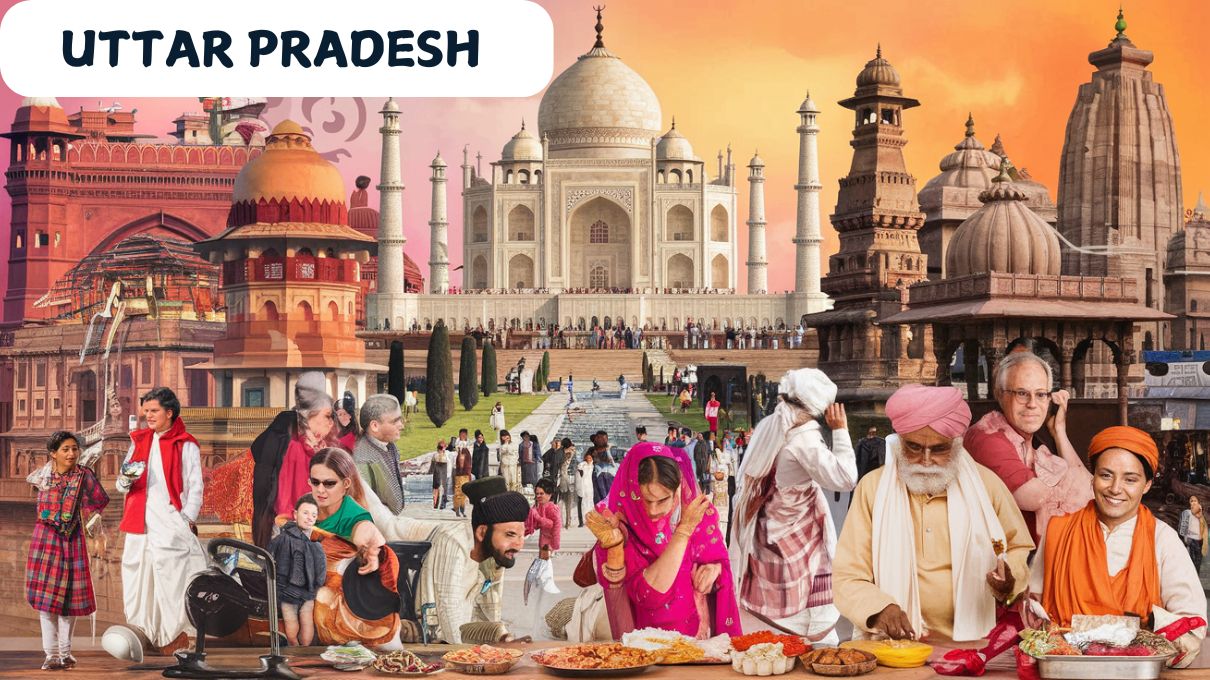All about Uttar Pradesh
Uttar Pradesh, often abbreviated as UP, is the most populous state in India and the most populous subnational entity in the world, with over 241 million residents. It accounts for 16.5% of India’s population and approximately 3% of the global population. Geographically, it is the fourth-largest state in India, covering an area of 243,286 km². The state shares its borders with Rajasthan, Haryana, Himachal Pradesh, Delhi, Uttarakhand, Nepal, Bihar, Madhya Pradesh, Chhattisgarh, and Jharkhand. The state capital is Lucknow, while Prayagraj serves as the judicial capital. UP is divided into 18 divisions and 75 districts, reflecting its administrative significance.
Formed in 1950, Uttar Pradesh is the successor to the United Provinces, established in 1935 and rooted in the earlier North-Western Provinces and Oudh Province of 1902. The state has a significant historical and cultural legacy, having been home to major empires like the Maurya, Gupta, Harsha, and Mughal Empires. It also played a pivotal role in the 1857 rebellion against British rule and was a focal point of the Indian independence movement.
Uttar Pradesh: A Hub of History, Culture, Economy
The state’s economy is the third largest in India, with a Gross State Domestic Product (GSDP) of ₹18.63 lakh crore (US$220 billion) and a per capita GSDP of ₹68,810 (US$820). Historically renowned for sugar production, its economy is now led by the services sector, which includes tourism, hospitality, real estate, and financial consultancies. UP contributes 80 seats to the Lok Sabha and 31 seats to the Rajya Sabha, underscoring its significant role in India’s political landscape.
In 2000, the state was divided, leading to the creation of Uttaranchal (now Uttarakhand) from its western Himalayan region. Uttar Pradesh is also home to major rivers like the Ganges and Yamuna, which meet at the Triveni Sangam in Prayagraj, a prominent Hindu pilgrimage site. Other significant rivers include the Gomti and Saryu. The state has 6.1% forest cover, while 82% of the land is cultivable, making it a key agricultural hub.
The cultural diversity of Uttar Pradesh is reflected in its population, primarily comprising Awadhi, Brajwasi, and Bundeli communities. Hinduism is practiced by the majority, followed by Islam, and the state recognizes Hindi and Urdu as its official languages. UP is home to a wealth of holy temples, pilgrimage centers, and historical sites. Iconic cities like Agra, Ayodhya, Varanasi, Mathura, and Vrindavan attract visitors for their religious and historical significance. The state also boasts three UNESCO World Heritage sites, highlighting its global cultural importance.
History of Uttar Pradesh
The history of Uttar Pradesh spans thousands of years, reflecting its prominence as a hub of human civilization, culture, and politics. From prehistoric settlements to the rise and fall of great empires, Uttar Pradesh has played a central role in shaping the history of India.
Prehistoric Period
- Ancient Human Settlements: Evidence suggests that modern human hunter-gatherers have lived in Uttar Pradesh for approximately 85,000–72,000 years. Archaeological findings from the Middle and Upper Paleolithic periods, dating back 21,000–31,000 years, reveal early human presence.
- Mesolithic and Early Agriculture: Around 10,550–9,550 BCE, Mesolithic communities near Pratapgarh practiced hunting and gathering. By 6000 BCE, villages began to emerge, featuring domesticated animals and early forms of agriculture, leading to the development of complex societies.
- Indus Valley Influence and Vedic Culture: Between 4000 and 1500 BCE, the region was influenced by the Indus Valley Civilization and later became central to the Vedic period, ushering in significant cultural and religious developments.
Ancient and Classical Period
- Mahajanapadas: Uttar Pradesh was home to seven of the sixteen Mahajanapadas, or ancient republics, that dominated the Indian subcontinent during the 6th century BCE. Notable among these was Kosala, with Ayodhya as its capital, believed to be the birthplace of Lord Rama from the Ramayana.
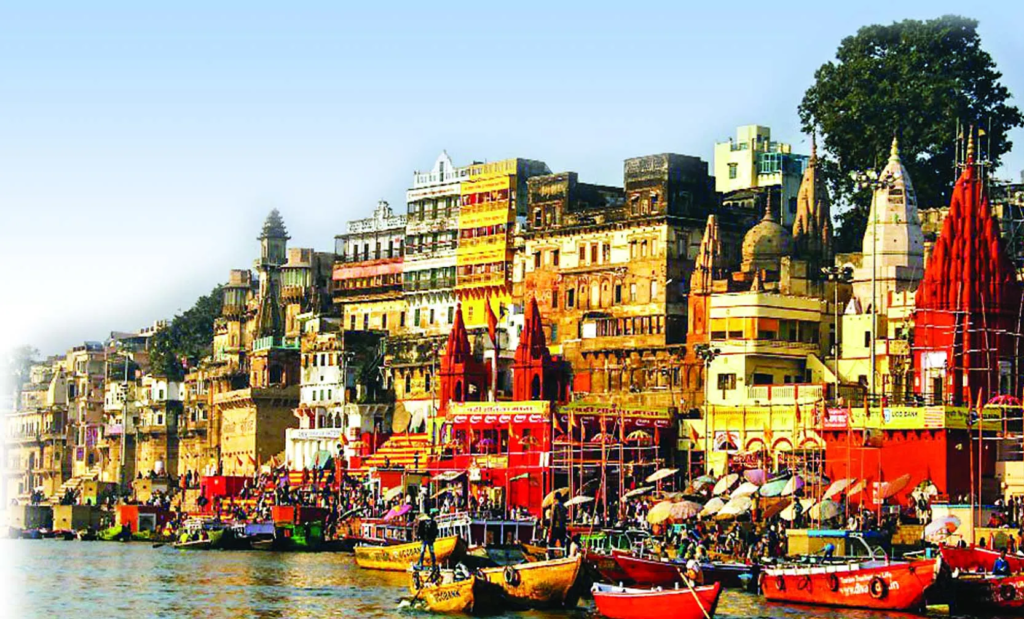
- Krishna and Mathura: The city of Mathura is revered as the birthplace of Lord Krishna, a central figure in Hindu mythology and a pivotal character in the Mahabharata.
- Rise of Empires: The Gangetic plains of Uttar Pradesh were vital to major Indian empires, including:
- Maurya Empire (320–200 BCE): Known for uniting large parts of India under Emperor Ashoka.
- Gupta Empire (350–600 CE): Representing a golden age of Indian culture, arts, and science.
- Gurjara-Pratihara Empire (650–1036 CE): Dominated northern India after the decline of the Guptas.
- Kannauj as a Power Center: During the reign of Emperor Harshavardhana (590–647 CE), Kannauj reached its zenith, controlling vast territories across the Indo-Gangetic plain. Kannauj remained a highly contested region, facing invasions from Bengal’s Pala Empire, the Rashtrakutas of South India, and other regional powers.
Delhi Sultanate Period (1206–1526)
Uttar Pradesh came under the rule of the Delhi Sultanate for over three centuries, witnessing significant socio-political and cultural changes.
- Dynasties and Conquests:
- The Mamluk dynasty established control over key regions like Meerut and Aligarh.
- Alauddin Khalji extended his rule to Varanasi and Prayagraj.
- The Tughlaq dynasty consolidated power, building notable structures like the Atala Masjid in Jaunpur and Ghiyath al-Din Tughluq’s Tomb.
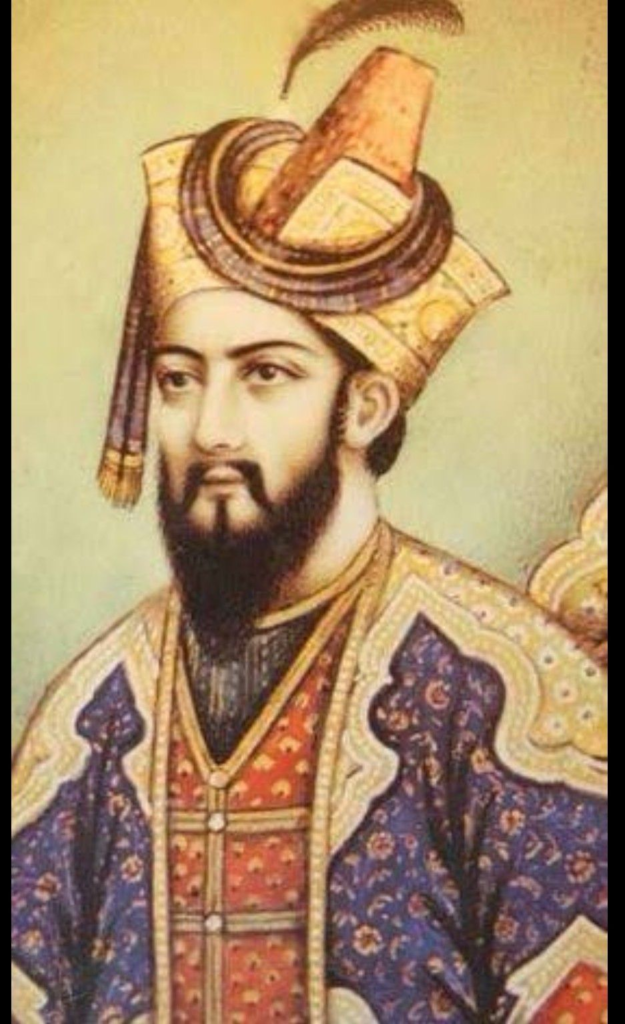
- Sufi Influence: Sufism flourished in Uttar Pradesh during this era. Prominent Sufi saints, such as Nizamuddin Auliya and Qutbuddin Bakhtiar Kaki, spread their teachings, leaving a profound impact on the spiritual and cultural landscape.
- Architectural Legacy: The period saw the construction of numerous mosques and tombs, reflecting the architectural style of the time.
Significance in Indian History
Uttar Pradesh’s history highlights its role as a cradle of Indian civilization, a site of religious significance, and a battleground for political dominance. Its cities like Varanasi, Mathura, and Ayodhya remain pivotal in India’s cultural and spiritual heritage. The region’s contributions to literature, philosophy, and governance during ancient and medieval times underscore its historical importance.
Medieval and Early Modern Period
The medieval and early modern history of Uttar Pradesh reflects its transformation into a significant political, cultural, and administrative center under successive empires. From the rise of the Mughal Empire to its eventual decline and the influence of the British East India Company, the region has been at the crossroads of historical change.
Mughal Period (1526–1757)
- Establishment of the Mughal Empire: In the 16th century, Babur, a Timurid prince from modern-day Uzbekistan, defeated the Delhi Sultanate and established the Mughal Empire. Uttar Pradesh became the heartland of this vast empire, with emperors like Babur and Humayun ruling from Delhi.
- Sher Shah Suri’s Reign: In 1540, Afghan ruler Sher Shah Suri defeated Humayun and established his capital at Gwalior. His rule brought significant administrative reforms, including the introduction of the Grand Trunk Road.
- Hemu’s Brief Rule: After Sher Shah’s death, his minister Hemu, also known as Hemchandra Vikramaditya, assumed power. However, his reign ended following his defeat in the Second Battle of Panipat (1556).
- Akbar’s Era: Emperor Akbar ruled from Agra and later Fatehpur Sikri, making Uttar Pradesh a political and cultural hub. Akbar’s court fostered advancements in art, literature, and architecture, exemplified by structures like the Buland Darwaza.
- Decline of Mughal Authority: By the 18th century, Mughal power waned, giving rise to new regional players like the Rohillas in Rohilkhand and the Marathas, who briefly controlled parts of the state before the British East India Company’s ascendancy.

British Era (1803–1947)
With the decline of the Maratha Empire following the Second Anglo-Maratha War (1803–1804), Uttar Pradesh came under British control.
Administrative Evolution
- Naming and Boundaries:
- Initially termed the Ceded and Conquered Provinces in 1807.
- Renamed the North-Western Provinces in 1836.
- In 1902, it became the United Provinces of Agra and Oudh, commonly referred to as the United Provinces (UP).
- Revolts and Reorganization:
- The Indian Rebellion of 1857 began in Meerut and spread across northern India. Leaders like Mangal Pandey ignited the movement against British rule.
- Following the revolt’s suppression, administrative changes split rebellious regions, with Oudh being incorporated into UP, and Delhi merged with Punjab.
Role in the Independence Movement
- Emergence of Nationalist Leaders: Uttar Pradesh was home to prominent figures of the Indian National Congress, including Motilal Nehru, Jawaharlal Nehru, Madan Mohan Malaviya, and Govind Ballabh Pant.

- Farmers’ Movements: The All-India Kisan Sabha, established in 1936 in Lucknow, addressed agrarian issues, inspiring farmer-led protests against feudal landlords.
- Rebellion in Ballia: During the Quit India Movement (1942), Ballia district briefly declared independence, earning the nickname “Baghi Ballia” (Rebel Ballia).
- Cultural Hubs: Institutions like Aligarh Muslim University and Banaras Hindu University played crucial roles in fostering education and nationalism.

Post-Independence Period
- Formation of Uttar Pradesh: After India gained independence in 1947, the United Provinces were renamed Uttar Pradesh on 24 January 1950. In 2000, its northern districts were carved out to form the state of Uttarakhand.
- Political Significance: Uttar Pradesh has been pivotal in Indian politics, producing nine prime ministers, including Jawaharlal Nehru, Indira Gandhi, and Atal Bihari Vajpayee.
- Challenges:
- Despite its historical and political prominence, Uttar Pradesh struggles with issues such as economic underdevelopment, corruption, and caste-based violence.
- The Babri Masjid demolition (1992) in Ayodhya sparked widespread communal unrest, highlighting ongoing religious tensions.
- Legacy: Today, Uttar Pradesh remains a land of historical and cultural richness, bearing the legacy of empires, movements, and resilience that have shaped India.
Geography of Uttar Pradesh
Uttar Pradesh, spanning an area of 240,928 square kilometers (93,023 sq mi), ranks as India’s fourth-largest state by land area, comparable in size to the United Kingdom. Situated in northern India, it shares an international border with Nepal and features diverse geographical zones, from the Himalayan foothills in the north to the Vindhya Range and plateau region in the south.
Topography and Regions
The state can be broadly divided into:
- The Gangetic Plain:
- Dominates the northern landscape.
- Subdivided into the Ganges-Yamuna Doab, Ghaghra plains, Ganges plains, and Terai region.
- Characterized by fertile alluvial soil, making it an agricultural hub.
- The Vindhya Range and Plateau:
- Found in the southern parts.
- Features hard rock strata, valleys, and plateaus, contrasting with the plains.
- Bhabhar and Terai Regions:
- The Bhabhar belt, near the Himalayan foothills, consists of porous soil that absorbs rivers.
- The Terai zone lies adjacent, featuring marshes, swamps, and thick forests.
Major Rivers
Uttar Pradesh boasts a network of over 32 rivers, with the most significant being:
- Ganga
- Yamuna
- Saraswati
- Sarayu
- Betwa
- Ghaghara
These rivers hold religious and cultural significance in Hinduism, drawing pilgrims from across India.
Agriculture
The fertile plains enable intensive cultivation, particularly in the Middle and Upper Gangetic Plains and the Central Plateau and Hills regions. Despite abundant farming, the eastern districts face challenges like floods and droughts, while the central and western regions often deal with waterlogging.
Climate of Uttar Pradesh
Uttar Pradesh experiences a humid subtropical climate with distinct four seasons:
- Winter (January-February): Temperatures can drop near freezing.
- Summer (March-May): Extremely hot, with temperatures reaching 50°C (122°F) in some areas, accompanied by dry, hot winds (Loo).
- Monsoon (June-September): Brings heavy rainfall, contributing to the state’s agriculture.
- Post-Monsoon/Autumn (October-December): Moderate temperatures prevail.
Rainfall Patterns
The state receives annual rainfall ranging from:
- 170 cm (67 inches) in hilly areas.
- 84 cm (33 inches) in Western Uttar Pradesh.
The Bay of Bengal monsoon branch is the primary source of precipitation, with occasional contributions from western disturbances during winter.
Floods and Droughts
The concentrated rainfall during monsoon months often results in:
- Flooding in low-lying regions.
- Droughts due to uneven distribution of rain.
Temperature and Sunshine
- Summers: Hot and arid, with maximum temperatures between 30–38°C (86–100°F).
- Winters: Mild and pleasant.
- Sunshine: The state enjoys approximately 2,900 hours of sunshine annually, supporting agriculture and solar energy potential.
Agro-Climatic Zones
Uttar Pradesh encompasses three agro-climatic zones:
- Middle Gangetic Plains (Zone IV).
- Upper Gangetic Plains (Zone V).
- Central Plateau and Hills (Zone VIII).
These zones reflect the state’s geographical and climatic diversity, impacting its agricultural patterns and crop choices. For instance, fertile soil in the Gangetic Plains supports crops like wheat, rice, and sugarcane, while terraced hill slopes enable cultivation of fruits and vegetables.
Flora and Fauna of Uttar Pradesh
Uttar Pradesh boasts rich biodiversity despite challenges like deforestation and poaching. With recorded forest cover of 16,583 km² (6,403 sq mi), representing 6.9% of the state’s area, it is home to a variety of plant and animal species. The state’s diverse ecosystems, ranging from Terai grasslands to tropical deciduous forests, provide habitats for both common and endangered species.
State Symbols
- State Animal: Swamp deer (Rucervus duvaucelii).
- State Bird: Sarus crane (Antigone antigone).
- State Tree: Ashoka (Saraca asoca).
- State Flower: Palash (Butea monosperma).
These symbols reflect the state’s natural heritage and cultural significance.
Flora
Uttar Pradesh is home to:
- Tropical Dry Deciduous Forests:
- Spread across the plains.
- Feature abundant shrubs and grasses due to high sunlight exposure.
- Large tracts have been cleared for agriculture.
- Moist Deciduous Forests:
- Found along riverbanks, particularly in the upper Gangetic plain.
- Support a variety of medicinal plants and native tree species.
- Scrublands and Thorny Forests:
- Common in the Vindhya region.
- Characterized by trees like Babool (Vachellia nilotica).
- Terai Grasslands:
- Known for elephant grass and a mix of marshes and swamps.
The forests support timber, medicinal plants, and essential biodiversity, while agricultural plantations coexist alongside natural vegetation.
Fauna
The state’s fauna includes:
- Mammals:
- Swamp deer, chinkara (Indian gazelle), and tigers inhabit forests and grasslands.

- The Gangetic plains support aquatic mammals like the Ganges River dolphin (Platanista gangetica), an endangered species.
- Birds:
- Uttar Pradesh is known for its extensive avifauna.
- Common species include doves, peafowl, quails, kingfishers, and woodpeckers.
- Important bird sanctuaries:
- Bakhira Sanctuary
- National Chambal Sanctuary
- Chandra Prabha Wildlife Sanctuary
- Hastinapur Wildlife Sanctuary
- Okhla Bird Sanctuary

- Reptiles:
- Gharials (Gavialis gangeticus), cobras, and lizards are prevalent, particularly near rivers.
- Aquatic Life:
- Rivers like the Ganges harbor species such as mahaseer, trout, and crabs.
- Endangered gharials, fish-eating crocodilians, are iconic in the Ganges ecosystem.
Biodiversity Threats
Despite the abundance of wildlife, several species face threats:
- Extinct Species: Lions from the Gangetic plains and rhinoceroses from the Terai.
- Endangered Species: Ganges river dolphin and gharials.
- Habitat destruction, poaching, and pollution are key challenges, necessitating government regulation and conservation programs.
Wildlife Conservation Efforts
The state hosts several protected areas and initiatives:
- National Parks and Reserves:
- Dudhwa National Park: A prominent tiger reserve.
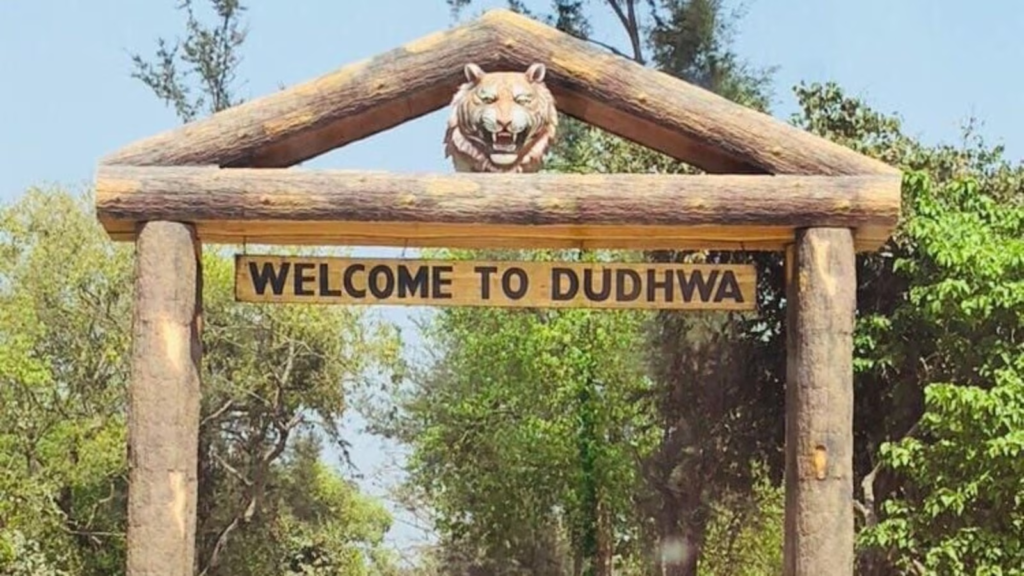
- Pilibhit Tiger Reserve: A vital habitat for tigers and swamp deer.
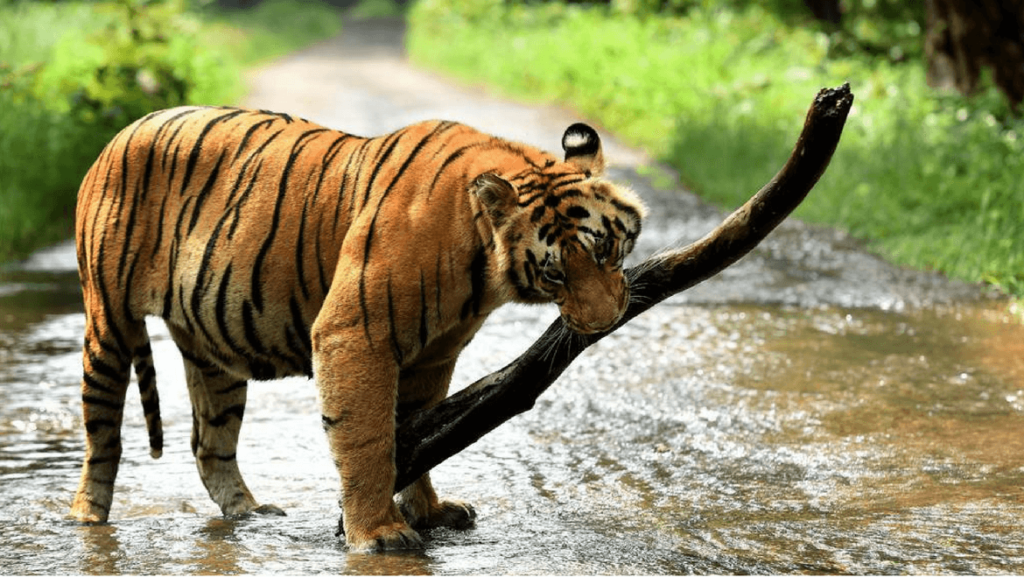
- Community Engagement: Local communities are increasingly involved in conservation through eco-tourism and sustainable practices.
Administrative Divisions of Uttar Pradesh
Uttar Pradesh, India’s most populous state, is divided into 18 administrative divisions and 75 districts. Each district operates under a District Magistrate (DM), an IAS officer reporting to the Divisional Commissioner, who oversees the division. Districts are further divided into subdivisions managed by Sub-Divisional Magistrates, and these subdivisions are broken into blocks, which consist of panchayats (village councils) and urban municipalities.
Key Divisions
The state’s 18 divisions include Lucknow, Kanpur, Varanasi, Meerut, Gorakhpur, Prayagraj, and Jhansi, among others. Major districts like Prayagraj, Lucknow, and Ghaziabad are notable for their population, literacy, and urban growth.
Population and Rankings
Uttar Pradesh leads in metropolitan city count among Indian states, with urban population accounting for 44.4 million people (11.8% of India’s urban population). Districts like Kanpur Nagar, Lucknow, and Ghaziabad are economic and cultural hubs.
- Largest District by Population: Prayagraj (5.95 million).
- Highest Literacy Rate: Kanpur Nagar (79.65%).
- Largest Growth Rate: Ghaziabad (42.27%).
Efforts for administrative decentralization include proposals for new states like Purvanchal and Bundelkhand, but these remain unimplemented.
Cities and Urban Governance in Uttar Pradesh
Uttar Pradesh is home to 15 urban agglomerations exceeding 500,000 population. Cities like Lucknow, Kanpur, Varanasi, and Noida showcase significant economic, cultural, and infrastructural development. Governance structures vary based on city size and population.
Urban Local Bodies
- Municipal Corporations (Nagar Nigam):
- Found in large cities such as Lucknow and Kanpur.
- Governed by mayors and elected councilors.
- Municipal Councils (Nagar Palika Parishad):
- Serve medium-sized towns like Jalaun.
- Administered by a chairperson and councilors.
- Nagar Panchayats:
- Operate in smaller towns or semi-urban areas like Badlapur.
- Managed by a chairman and councilors.
Special Administrative Zones
- Noida and Greater Noida in Gautam Buddha Nagar district are administered under the Uttar Pradesh Industrial Development Act, 1976, catering to their industrial and infrastructural needs.
Demographics of Uttar Pradesh
Uttar Pradesh, the most populous state in India, is home to 199.6 million people as per the 2011 Census, accounting for 16.2% of India’s population. The state’s estimated population in 2021 stands at 240 million, with a population density of 828 people per square kilometer, making it one of the densest regions in India.
Religious Composition
The state hosts India’s largest populations of Hindus and Muslims:
- Hinduism: 79.73%
- Islam: 19.26%
- Other Religions (Sikhism, Christianity, Buddhism, Jainism): Less than 1%.
Linguistic Diversity
Hindi is the primary official language spoken by 80.16% of the population. Other major languages include:
- Bhojpuri: 10.93%
- Urdu: 5.42%
- Awadhi: 1.9%.
Urdu holds status as the second official language, and English is widely used for education and administration.
Socioeconomic Indicators
Literacy
Uttar Pradesh’s literacy rate is 67.7% (2011 Census), below the national average of 74%:
- Male Literacy: 79%
- Female Literacy: 59%
According to a 2020 NSO survey, the literacy rate improved to 73%, with notable rural-urban disparities.
Sex Ratio
The state has a sex ratio of 912 women per 1000 men (2011), lower than the national average of 943. Factors like female infanticide and gender discrimination contribute to this gap.
Poverty
Uttar Pradesh has the largest number of people below the poverty line (59 million in 2011-12). The state’s per capita income is under ₹80,000, reflecting slow poverty reduction compared to other states.
Economic Inequality
Central and eastern districts face high levels of poverty and widening income inequality, highlighting a need for equitable development policies.
This demographic composition underscores Uttar Pradesh’s diverse cultural fabric and development challenges.
Governance and Administration of Uttar Pradesh
Uttar Pradesh operates under a parliamentary system of representative democracy. The state has a bicameral legislature, one of only seven such states in India, consisting of:
- Vidhan Sabha (Legislative Assembly): Comprising 404 members elected for five-year terms.
- Vidhan Parishad (Legislative Council): A permanent body of 100 members, with one-third retiring every two years.
Key Features of Governance
- Governor: The constitutional head, appointed by the President of India for a five-year term.
- Chief Minister: The leader of the majority party or coalition in the Vidhan Sabha, responsible for day-to-day governance.
- Council of Ministers: Includes Cabinet Ministers and Ministers of State (MoS), supported by a Secretariat led by the Chief Secretary.
- Administrative Divisions: The state is divided into 18 divisions and 75 districts, each headed by a District Magistrate, an IAS officer.
Law and Order
- Judiciary: Headed by the Allahabad High Court, with a Lucknow Bench. The judiciary includes district and lower courts, divided into civil and criminal judicial services.
- Police Force: Uttar Pradesh has the largest police force globally, overseen by an IPS officer, the Director General of Police.
- Forest Administration: Managed by the Indian Forest Service, responsible for environmental conservation.
Political Landscape
Politics in Uttar Pradesh is dominated by four major parties:
- Bharatiya Janata Party (BJP)
- Samajwadi Party (SP)
- Bahujan Samaj Party (BSP)
- Indian National Congress (INC)
Despite producing eight Prime Ministers, including stalwarts like Jawaharlal Nehru and Atal Bihari Vajpayee, the state faces challenges like caste-based tensions, communal conflicts, and polarization.
Crime and Safety
Crime Statistics
- Uttar Pradesh recorded the highest number of custodial deaths and encounter killings in India, with districts like Bareilly and Agra reporting the highest incidents.
- Communal violence is prevalent, with the state accounting for 23% of all such incidents in India.
Road Accidents
- Uttar Pradesh reported 41,746 road accident fatalities in 2022, the highest in India.
- Key causes: Over-speeding (40%), drunken driving (10%), wrong-side driving (12%), and mobile phone usage (10%).
Terrorist Incidents
- Major attacks include the 2006 Varanasi bombings, 2007 court blasts, and 2010 Sheetla Ghat blast, highlighting the state’s vulnerability to terrorism.
Development Challenges
Despite being a political powerhouse, Uttar Pradesh struggles with:
- Human Development Index (HDI): Ranked low nationally, with a value rising from 0.39 in 1990 to 0.59 in 2017, reflecting slow progress.
- Inequality: Economic disparity and inadequate human development programs persist.
The state’s administration, while extensive, faces hurdles in improving safety, infrastructure, and public welfare. These challenges demand innovative policies and better governance to harness Uttar Pradesh’s potential as India’s most populous state.
Economy of Uttar Pradesh
Uttar Pradesh, often referred to as the “Heartland of India,” plays a significant role in the country’s economy. With a diverse economic structure, it ranks as the fourth-largest economy in India in terms of Net State Domestic Product (NSDP). Its economy is driven by agriculture, manufacturing, and the services sector, showcasing a balanced contribution from all major industries.
Agriculture: The Backbone of Uttar Pradesh
Agriculture remains the largest employment generator, owing to the state’s location in the fertile Indo-Gangetic Plain. Key agricultural highlights include:
- Food Grain Production: Uttar Pradesh contributes 19% of India’s total food grain output, making it a critical player in the nation’s food security.
- Sugarcane Production: As the largest producer of sugarcane in India, the state supplies 70% of the country’s sugar.
- Diverse Crops: Alongside sugarcane, the state cultivates wheat, rice, and sunflower as key crops, supporting a robust agrarian economy.
Despite its dominance in agriculture, the sector faces challenges like regional disparities in productivity and infrastructure gaps, particularly in eastern Uttar Pradesh.
Industrial and Manufacturing Sector
The state’s secondary sector contributes significantly to its economic output, primarily through small and medium enterprises (SMEs) and traditional industries:
- Manufacturing Clusters: With 359 manufacturing clusters, the cement industry leads the SME segment.
- Traditional Industries: Textiles and sugar refining remain prominent, employing a large share of the industrial workforce.
- Infrastructure for Growth: Industrial hubs in cities like Noida, Kanpur, and Lucknow drive modern industrial growth.
However, regional imbalances and limited infrastructure in certain areas have hindered the sector’s full potential.
Service Sector: The Growth Engine
The service sector is the largest contributor to Uttar Pradesh’s economy, accounting for 44.8% of the state’s GDP. Notable features include:
- IT and Technology: Noida has emerged as a significant IT hub, hosting world-class IT parks and attracting major companies.
- Tourism: Historical landmarks like the Taj Mahal, religious hubs, and cultural heritage sites boost the state’s revenue through domestic and international tourism.
- Urban Development: Cities like Agra, Meerut, and Noida rank high in per capita income due to advanced urban infrastructure and services.
Economic Challenges
Despite its economic strengths, Uttar Pradesh faces persistent challenges:
- Unemployment: The unemployment rate rose to 21.5% in April 2020, reflecting the state’s struggle to create jobs.
- Migration: Uttar Pradesh accounts for the largest number of migrants moving out of the state, primarily due to lack of employment opportunities.
- Regional Disparities: Eastern Uttar Pradesh lags significantly in development indicators compared to the western and central regions.
- Debt Burden: As of 2019–20, the state’s debt burden stood at 29.8% of its GSDP, limiting fiscal flexibility.
Future Prospects
To harness its potential, Uttar Pradesh is investing in infrastructure development, industrial policies, and ease-of-doing-business reforms. Key initiatives include:
- Improved Connectivity: Projects like the Ganga Expressway aim to enhance regional connectivity.
- Industrial Expansion: Focus on smart cities and special economic zones (SEZs) to attract investments.
- Sustainable Agriculture: Efforts to modernize farming practices and improve rural infrastructure.
Uttar Pradesh’s economy, despite its challenges, holds immense promise as a hub for agriculture, manufacturing, and services, contributing significantly to India’s growth story.
Transportation in Uttar Pradesh
Uttar Pradesh, India’s most populous state, boasts an extensive and diverse transportation network. With a robust system spanning railways, roads, and airports, the state’s transportation infrastructure is crucial to its economic and social development.
Railway Network
Uttar Pradesh has the largest railway network in India, extending over 9,077 km (5,640 miles) of tracks. Despite its vast network, the state ranks only sixth in terms of railway density. The railway system is managed by two divisions of Indian Railways: North Central Railway (headquartered in Allahabad) and Northeastern Railway (headquartered in Gorakhpur), along with the Northern Railway Division, based in Lucknow and Moradabad.
- Major Stations: Uttar Pradesh is home to some of the 50 world-class railway stations in India, including Prayagraj Junction, Agra Cantonment, Lucknow Charbagh, Kanpur Central, and Varanasi Junction.
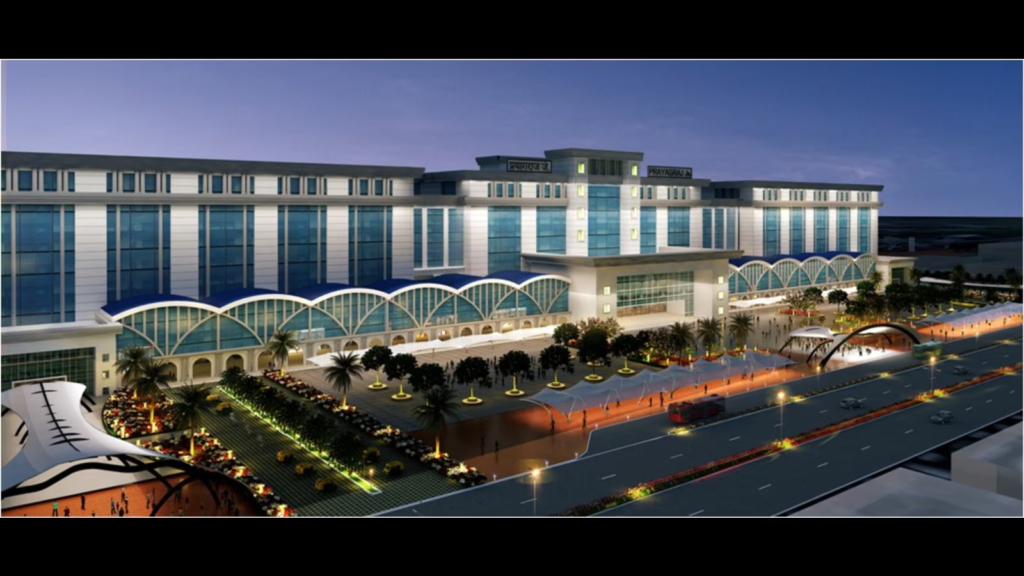
- Shatabdi Express: The Lucknow Swarna Shatabdi Express and Kanpur Shatabdi Express are among the fastest trains in India, connecting major cities like New Delhi, Lucknow, and Kanpur with modern LHB coaches.
- Metro Systems: The Lucknow Metro and Kanpur Metro provide efficient rapid transit within their respective cities, enhancing urban mobility.
Road Network
Uttar Pradesh also has the largest road network in India, with 42 national highways covering a total length of 4,942 km (3,071 miles), contributing 8.9% of India’s national highways. The state’s extensive road infrastructure plays a vital role in connecting urban and rural areas, with continuous upgrades to the road network.
- State Road Transport: The Uttar Pradesh State Road Transport Corporation (UPSRTC) operates a fleet of 11,238 buses across 2,762 routes, serving 768,065 km of routes within the state. Despite its large operation, concerns have been raised about the condition of many buses, affecting passenger safety.
- Highway Projects: Key infrastructure projects, such as the Agra–Lucknow Expressway (302 km), are part of ongoing efforts to improve connectivity between major cities.

- Road Density: Uttar Pradesh has the highest road density in India, with 1,027 km of roads per 1,000 square kilometers, supporting the state’s growing transportation needs.
Airports
Uttar Pradesh has a network of international and domestic airports, with Lucknow and Varanasi serving as major gateways.
- International Airports:
- Chaudhary Charan Singh International Airport in Lucknow and Lal Bahadur Shastri International Airport in Varanasi are the primary international gateways, facilitating both passenger and cargo traffic.

- Kushinagar International Airport, a newly constructed facility, is expected to support international flights, though it has yet to begin operations.
- Domestic Airports: The state also has several domestic airports in Agra, Allahabad, Bareilly, Ghaziabad, Gorakhpur, and Kanpur, which cater to internal flights, with some also serving dual purposes for Indian Air Force operations during emergencies or disasters.
- Proposed Developments: The Noida International Airport near Jewar in Gautam Buddha Nagar is a key upcoming project, expected to boost aviation capacity in the region.
Challenges and Opportunities
While Uttar Pradesh’s transportation network is extensive, several challenges persist:
- Overburdened Infrastructure: The existing infrastructure, particularly the road network and bus service, faces strain due to the state’s high population density and increasing demand.
- Urban Congestion: Major cities like Lucknow, Kanpur, and Varanasi experience traffic congestion, necessitating the expansion of metro systems and road improvements.
- Modernization Needs: Continued investments are required to modernize the aging bus fleet of UPSRTC and improve the condition of roads, especially in rural and underdeveloped regions.
Sports in Uttar Pradesh
Uttar Pradesh has a rich sporting culture, encompassing both traditional and modern sports. While traditional sports have deep cultural roots in the state, modern sports like cricket and football have gained immense popularity over the years. The state also has a strong legacy in wrestling and field hockey, producing notable athletes.
Traditional Sports
Traditional sports in Uttar Pradesh, many of which were once part of the daily lives of the people, include wrestling, kabaddi, and track-and-field events, often played according to local rules and without modern equipment. Some of these sports display martial skills, such as sword fighting and Pata (stick fighting).
- Wrestling: With its deep cultural roots, wrestling remains a prominent sport in Uttar Pradesh, especially in rural areas. Akharas (traditional wrestling schools) are found across the state, preserving the practice of Kushti and helping develop many successful wrestlers.
- Kabaddi: Kabaddi is another traditional sport that remains popular in the state, often played during local festivals and gatherings.

However, these traditional sports are largely unorganised and survive mainly as individual hobbies or local competitive events due to the lack of structured patronage and adequate facilities.
Modern Sports
- Cricket: Cricket has emerged as the most popular sport in Uttar Pradesh in recent years, surpassing even field hockey. Uttar Pradesh’s cricket team has made significant strides in domestic tournaments, with its first Ranji Trophy win in February 2006, defeating Bengal in the final.
- Shaheed Vijay Singh Pathik Sports Complex, a newly built international cricket stadium, serves as a major venue for cricket matches in the state, with a seating capacity of 20,000 spectators.
- Field Hockey: While cricket has gained more popularity, field hockey still enjoys a significant following in Uttar Pradesh. The state has produced top-level players like Nitin Kumar and Lalit Kumar Upadhyay, who have contributed to India’s success in the sport.
- Football: The Uttar Pradesh Football Association (UPFA) is the governing body for football in the state, overseeing the development of the sport and representing the state in various National Football Championships. The association manages two regional football bodies: the Aligarh Football Association and the Kanpur Football Association. Despite being overshadowed by cricket, football has a growing presence, with several local clubs and tournaments fostering the sport’s development.
- Badminton: Badminton is another sport gaining prominence, with the Uttar Pradesh Badminton Association overseeing the development of the sport in the state. The association ensures that players from Uttar Pradesh compete at the national level, contributing to the state’s reputation in the sport.
Motorsports
Uttar Pradesh is also home to the Buddh International Circuit in Greater Noida, which hosted India’s inaugural Formula 1 Grand Prix on 30 October 2011. The event attracted significant attention but was cancelled after only three races due to falling attendance and lack of government support. The Uttar Pradesh government, considering Formula One more as an entertainment event than a sport, imposed taxes on the event and participants, leading to its eventual cancellation.

Challenges and Future Prospects
Despite the state’s rich sporting history, Uttar Pradesh faces several challenges in terms of infrastructure development, organised patronage, and lack of professional training facilities for many traditional sports. The lack of government support and insufficient investment in the sporting ecosystem hinder the growth of certain sports.
However, with more focus on modern sports like cricket and football, along with an increasing interest in other sports like badminton and motorsports, Uttar Pradesh has the potential to emerge as a sports hub in India. Continued investment in infrastructure, coupled with an increase in organised sporting events and training opportunities, could pave the way for a thriving sports culture in the state.
Education in Uttar Pradesh
Uttar Pradesh has a deep-rooted tradition of education, which, over the centuries, has evolved and expanded. Historically, education was mostly confined to the elite class and religious schools. During ancient times, Sanskrit-based learning dominated the region, particularly from the Vedic period to the Gupta period. As different cultures and civilizations traveled through the region, they introduced Pali, Persian, and Arabic scholarship, which enriched the educational landscape. These diverse streams of knowledge laid the foundation for a Hindu-Buddhist-Muslim education system that continued until the British colonial period.
Modern Education System
The contemporary education system in Uttar Pradesh largely mirrors the British colonial education system, which was introduced by foreign Christian missionaries and the British administration. Today, schools in the state are either government-managed or run by private trusts. The medium of instruction in most schools is Hindi, except for those affiliated with central boards like CBSE or ICSE, where English is predominantly used.
Uttar Pradesh follows the 10+2+3 educational plan. After completing secondary school, students typically attend junior college or higher secondary schools, where they choose from three streams: liberal arts, commerce, or science. Following this, students can enroll in general or professional degree programs at various universities and colleges.
Challenges in Education
Despite its significant educational institutions, Uttar Pradesh faces several challenges in its education system:
- Funding: The state spends only ₹9,167 per pupil, which is below the national average of ₹12,768. This underfunding affects the quality of education, with inadequate infrastructure and limited resources.
- Teacher-Student Ratio: Uttar Pradesh has a teacher-pupil ratio of 39:1, which is higher than the national average of 23:1. This imbalance affects individual attention to students, especially in rural areas.
- Teacher Absenteeism: The state reports high teacher absenteeism at 31% in rural schools, one of the highest in India.
- Vacant Positions: As of 2020, about 17.1% of elementary teacher posts in government schools were vacant. Additionally, in February 2024, the state government reported a shortage of 85,152 teachers.
Higher Education in Uttar Pradesh
Uttar Pradesh is home to over 45 universities, including six central universities and twenty-eight state universities. Some of the prominent institutions include:
- Indian Institutes of Technology (IITs) in Kanpur and Varanasi, which are among the best in India for technical education.
- Indian Institute of Management (IIM) in Lucknow, a prestigious institution for management studies.
- AIIMS Gorakhpur and AIIMS Rae Bareli, which provide world-class healthcare education.
- Rajiv Gandhi Institute of Petroleum Technology (RGIPT) in Amethi, offering specialized education in petroleum and energy sectors.
- King George’s Medical University (KGMU) in Lucknow, a leading medical institution.
- Jagadguru Rambhadracharya Handicapped University, which is the only university in the world exclusively for people with disabilities.
Additionally, there are numerous colleges offering courses in engineering, medical sciences, arts, and commerce, contributing to the state’s growing educational infrastructure.
Libraries and Research Institutes
Uttar Pradesh also boasts several significant libraries and research institutes:
- Maulana Azad Library in Aligarh is one of the oldest and largest university libraries in Asia.
- Rampur Raza Library houses a rich collection of Indo-Islamic cultural heritage and is a repository for historical manuscripts.
- Thornhill Mayne Memorial Library in Allahabad is home to a collection of 125,000 books and rare manuscripts, including works in Arabic and Urdu.
Research institutes like the Central Drug Research Institute in Lucknow and the Central Institute of Higher Tibetan Studies contribute to academic and scientific advancements in the state.
Notable Scholars
Uttar Pradesh has produced many eminent scholars and leaders who have made significant contributions to Indian society. Some notable figures include:
- Harivansh Rai Bachchan, a famous poet.
- Motilal Nehru, an influential political leader.
- Harish Chandra, a renowned philosopher and historian.
- Indira Gandhi, the former Prime Minister of India, who studied in Uttar Pradesh.
Tourism in Uttar Pradesh
Uttar Pradesh is one of India’s most prominent tourist destinations, attracting millions of domestic and international visitors each year. The state is rich in history, culture, and religious significance, with a variety of attractions ranging from World Heritage Sites to revered religious sites, historical forts, and festivals. Tourism contributes significantly to the state’s economy, with both religious tourism and historical tourism playing key roles.
Key Attractions in Uttar Pradesh
- Taj Mahal
The Taj Mahal in Agra is undoubtedly the most famous tourist attraction in Uttar Pradesh and one of the Seven Wonders of the World. It attracts around 7 million visitors annually. Built by Emperor Shah Jahan in memory of his wife Mumtaz Mahal, the Taj Mahal is a symbol of eternal love and showcases stunning Mughal architecture. In 2018-19, the Taj Mahal alone earned approximately ₹78 crore (US$9.3 million) in ticket sales.
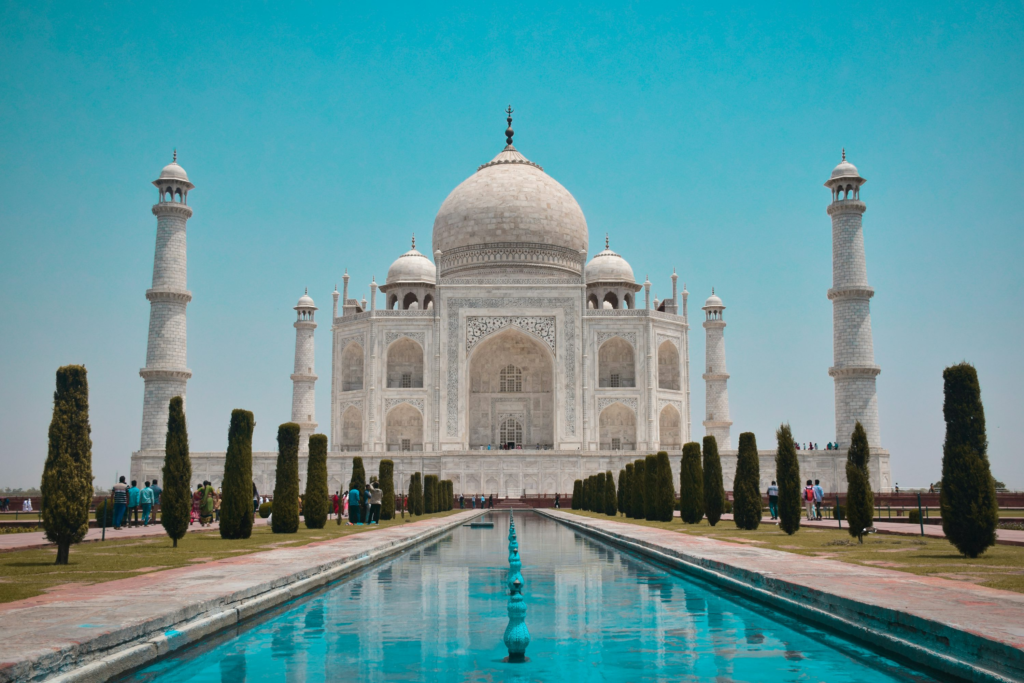
- Agra Fort and Fatehpur Sikri
Uttar Pradesh is home to three UNESCO World Heritage Sites, the Taj Mahal, Agra Fort, and Fatehpur Sikri. Agra Fort is a massive structure built by Emperor Akbar in the 16th century, offering panoramic views of the Taj Mahal. Fatehpur Sikri, located near Agra, was the capital of the Mughal Empire for a short time and contains numerous architectural gems, including the Buland Darwaza, one of the tallest gateways in India.

Religious Tourism
- Varanasi
Varanasi, one of the oldest living cities in the world, is an important religious hub for Hindus and Jains. As a sacred city, it attracts millions of pilgrims who come to bathe in the Ganges River and seek spiritual solace. Varanasi is known for its ghats, temples, and vibrant culture, with many tourists visiting Kashi Vishwanath Temple and witnessing the nightly Ganga Aarti.


- Vrindavan
Vrindavan, the birthplace of Lord Krishna, is a major pilgrimage site for Vaishnavism. The town is dotted with numerous temples and is known for its Krishna-related festivals like Holi and Janmashtami, which draw devotees from all over the world.

- Ayodhya
Ayodhya, believed to be the birthplace of Lord Rama, is one of the most revered places in Hinduism. It holds great significance in both the Ramayana and Hindu religious traditions. Millions of pilgrims visit Ayodhya, especially for festivals like Ram Navami.

- Prayagraj (Allahabad)
Prayagraj is renowned for its Magh Mela, a festival held every year on the banks of the Ganges. The Kumbh Mela, held every 12 years, is the largest religious gathering in the world, attracting over 10 million Hindu pilgrims. The city is also famous for the Triveni Sangam, the confluence of the Ganges, Yamuna, and mythical Saraswati rivers, which is considered a sacred spot for bathing. - Buddhist Pilgrimage Sites
Uttar Pradesh is a crucial destination for Buddhist tourism, with several important sites like Sarnath and Kushinagar. In Sarnath, Gautama Buddha gave his first sermon after attaining enlightenment. The Pillars of Ashoka and the Lion Capital of Ashoka, located in Sarnath, are significant archaeological treasures. Kushinagar, where the Buddha is believed to have passed away, is another major Buddhist pilgrimage site.
Historical and Architectural Sites
- Jhansi Fort
Located in the city of Jhansi, the Jhansi Fort is closely associated with the Indian Rebellion of 1857, also known as the First War of Indian Independence. The fort’s impressive architecture features thick walls, bastions, and a blend of Hindu and Islamic styles, reflecting its medieval military significance.
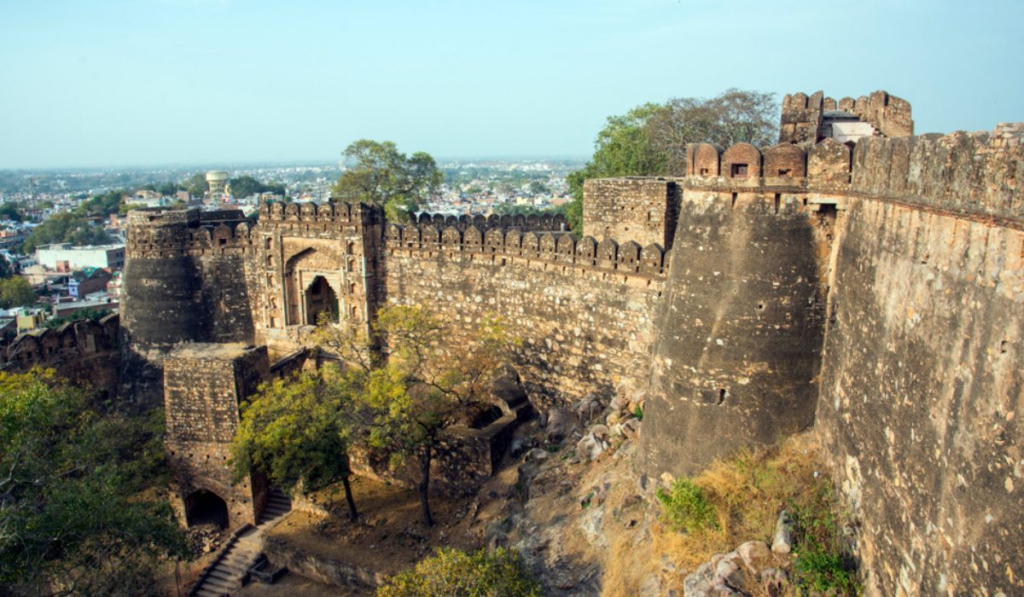
- Ghazipur
Ghazipur, located 80 km from Varanasi, is not only known for its Ganga ghats but also for the tomb of Lord Cornwallis, the 18th-century Governor of Bengal. The tomb, maintained by the Archaeological Survey of India, attracts history enthusiasts. - Kumbh Mela at Sangam
The Kumbh Mela, held at the Sangam (the confluence of the Ganges, Yamuna, and Saraswati) in Prayagraj, is a major event in the state, where millions of devotees gather to take a holy dip. The Kumbh Mela is held every 12 years and has a spiritual significance for Hindus worldwide.
Tourism Impact and Statistics
Uttar Pradesh is the top-ranked state in India for domestic tourist arrivals, with 110 million visitors in 2021. The state also welcomes foreign tourists, with about 44,000 international arrivals in the same year. The Taj Mahal alone accounts for a substantial portion of these numbers, reflecting the global appeal of Uttar Pradesh’s cultural and historical sites.
Healthcare in Uttar Pradesh
Uttar Pradesh, India’s most populous state, faces significant challenges in providing adequate healthcare to its residents. While the state has a combination of both public and private healthcare infrastructure, the demand for health services often exceeds the available resources. These challenges, coupled with rapid population growth, have strained the healthcare system and contributed to lower health outcomes compared to other states.
Public Healthcare System
The public healthcare system in Uttar Pradesh is structured through a network of primary health centers, community health centers, district hospitals, and medical colleges. However, despite this extensive infrastructure, the state struggles with significant gaps in service provision. For instance, while the state’s population has increased by more than 25% in the past 15 years, the number of public health centers has actually decreased by 8% over the same period.
Smaller sub-centers, which serve as the first point of public contact, have increased by only 2% over 25 years, despite a population growth of over 51% during this timeansion of infrastructure, coupled with a shortage of healthcare professionals, has placed considerable pressure on the public health system, especially in rural areas. The state is also plagued by insufficient essential medicines and medical equipment, leading to a reliance on private healthcare services that are often inaccessible to the economically disadvantaged.
Healthcare and Resources
As of 2019, Uttar Pradesh had 4,442 government hospitals, with 39,104 beds in rural areas and 37,156 beds in urban areas. The state has a large number of registered doctors—77,549—but the healthcare workforce remains inadequate to serve the growing population. On average, a government hospital in Uttar Pradesh serves 47,782 individuals, which highlights the disparity between the population’s needs and the available healthcare infrastructure.
In addition to these infrastrenges, Uttar Pradesh also faces a growing financial burden in healthcare. As of December 2023, out-of-pocket expenditures in the state amounted to ₹60,883 crore (US$7.3 billion), the highest in India. This figure indicates that a significant portion of the population relies on private healthcare, often leading to financial strain for families.
Health Indicators and Challer Pradesh’s health indicators are among the poorest in the country. The life expectancy in the state is notably lower than that of neighboring regions, with a newborn in Uttar Pradesh expected to live four years fewer than in Bihar, five years fewer than in Haryana, and seven years fewer than in Himachal Pradesh. The state has a high burden of both communicable and non-communicable diseases, contributing to a significant proportion of national deaths. For example, in 2014, Uttar Pradesh accounted for 48% of all typhoid deaths, and in 2015, it contributed to 17% of cancer deaths and 18% of tuberculosis deaths.

One of the most concerning aspects of the state’s htics is its maternal and child health indicators. Uttar Pradesh has one of the highest maternal mortality ratios in India, with 285 maternal deaths for every 100,000 live births as of 2021. Additionally, 64.2% of pregnant women in the state do not have access to the minimum ante-natal care. This is compounded by the fact that a significant number of births occur at home, with approximately 42% of pregnant women—over 1.5 million women—delivering babies at home. Alarmingly, 61% of these home births are considered unsafe, posing a serious risk to both mothers and infants.
The state also faces the highest child mortality rates 1,000 live births** dying before the age of five. Of these, 35 die within a month of birth, and 50 do not survive their first year. This reflects significant gaps in neonatal and maternal care services.
Private Healthcare Sector
While the public healthcare system in Uttar Pradesh iate healthcare sector** has flourished in recent years. Many urban centers, particularly Lucknow and Kanpur, have seen the emergence of private hospitals and clinics that cater to the upper and middle classes. However, the private sector remains largely inaccessible to the poorer segments of the population due to high treatment costs.
The private sector, although providing better quality healthcare in some instances, exacerbates the inequality in health outcomes as it predominantly serves those who can afford to pay for services. The rising cost of private healthcare has led many people to rely on government facilities, which are often underfunded, under-resourced, and overcrowded.
Culture of Uttar Pradesh
Uttar Pradesh, a state deeply rooted in India’s history and culture, is home to rich traditions, art forms, languages, music, dance, and literature that have shaped not only the state but also the wider Indian cultural landscape. With a historical connection to some of the greatest texts and philosophies, the culture of Uttar Pradesh reflects both its ancient heritage and its modern artistic expressions.
Language and Literature
Uttar Pradesh has been a significant center for language and literature throughout Indian history. The state played a pivotal role in the composition of several Vedic hymns and texts, establishing its importance as a cultural and spiritual hub. Among the great writers who resided in Uttar Pradesh were Kabir, Ravidas, and Tulsidas—the latter of whom wrote much of his famous Ram Charit Manas in Varanasi. The festival of Guru Purnima, dedicated to Sage Vyasa, is observed in the state as a mark of reverence to the author of the Vedas and the Mahabharata, believed to have been born on this day.

The Hindi language became the official language of the state with the Uttar Pradesh Official Language Act of 1951, and Urdu was added as an official language in 1989. Linguistically, the state represents several zones of Indo-Aryan languages, with Awadhi, Bagheli, Bundeli, Braj Bhasha, Kannauji, and Hindustani being the predominant languages. Additionally, Bhojpuri, a widely spoken Eastern Indo-Aryan language, also finds a place in the state’s linguistic fabric.
Music and Dance
The music and dance of Uttar Pradesh are as diverse as its cultural heritage. Traditional folk music in the state is categorized into three forms: music transmitted orally, music with unknown composers, and music performed by custom. During the medieval period, two distinct types of music emerged in Uttar Pradesh—courtly music, which thrived in cities like Agra, Fatehpur Sikri, Lucknow, and Jaunpur, and religious music, which was heavily influenced by the Bhakti movement, particularly in Mathura, Vrindavan, and Ayodhya.
Folk music plays an essential role in local celebrations. Sohar is sung during the birth of a child, while Kajari is performed during the monsoon season, associated with the Benares gharana. Other popular forms of music include Ghazal, Thumri, Qawwali, Rasiya, Khayal, and Biraha. These forms reflect various cultural influences, from Sufi poetry to regional traditions.
Kathak, one of India’s classical dance forms, originated in Uttar Pradesh. With its roots in the temple traditions of Varanasi, Kathak is known for its intricate footwork, expressive gestures, and storytelling through dance. The Ramlila, an ancient folk dance dramatizing the life of the Hindu deity Rama, is performed during festivals like Vijayadashami. Another significant traditional dance is Nautanki, a form of folk theatre that blends drama and music to depict a variety of historical, mythological, and social themes. The state also has two majors Gharanas of dance: Lucknow Gharana and Benares Gharana, both contributing to the growth of classical dance in India. Charkula, a regional dance from Braj, is another notable dance form.


Fairs and Festivals
Uttar Pradesh is renowned for its vibrant festivals and fairs that draw both locals and tourists. These celebrations highlight the state’s deep spiritual roots and the richness of its culture.
Chhath Puja is one of the most significant festivals in eastern Uttar Pradesh, especially in areas like Varanasi. This festival, dedicated to the sun god, is widely celebrated with devotion and is marked by fasting and offering prayers to the sun.

The Kumbh Mela, organized every twelve years at Prayagraj (formerly Allahabad), is the largest religious gathering in the world. The festival, held on the banks of the Ganges, attracts millions of Hindu pilgrims who come to bathe in the holy river, believing it will cleanse them of sins.

Lathmar Holi, celebrated in Barsana near Mathura, is a unique local celebration of the Hindu festival of Holi. It is distinguished by women playfully hitting men with sticks, and it takes place before the actual festival of Holi.
Taj Mahotsav is another prominent cultural festival celebrated annually in Agra, near the famous Taj Mahal. This festival showcases the cultural heritage of the Braj region and includes folk music, dance performances, and traditional crafts.
The Ganga Mahotsav, celebrated on Kartik Purnima, is a festival held at the Ganges in Varanasi. This celebration, which takes place fifteen days after Diwali, is dedicated to the river Ganga, with rituals, cultural programs, and a vibrant display of religious devotion.
Cuisine of Uttar Pradesh
The cuisine of Uttar Pradesh is a delightful blend of rich flavors, historical influences, and diverse regional specialties. The state is home to several distinctive culinary traditions, each with its unique characteristics. The food culture here reflects the historical significance of the state, which was ruled by many great dynasties, including the Mughal Empire. Mughlai and Awadhi cuisines are among the most famous, but there are also notable regional flavors, like Bhojpuri cuisine, which has its own appeal.
Mughlai Cuisine
Mughlai cuisine is one of the most prominent culinary traditions in Uttar Pradesh, particularly influenced by the imperial kitchens of the Mughal Empire. Known for its rich, aromatic flavors, Mughlai cuisine combines a variety of spices, herbs, and cooking techniques, which were introduced by the Mughal rulers from Central Asia. This style of cooking emphasizes the use of ghee, yogurt, saffron, and dry fruits, often creating lavish and indulgent dishes.
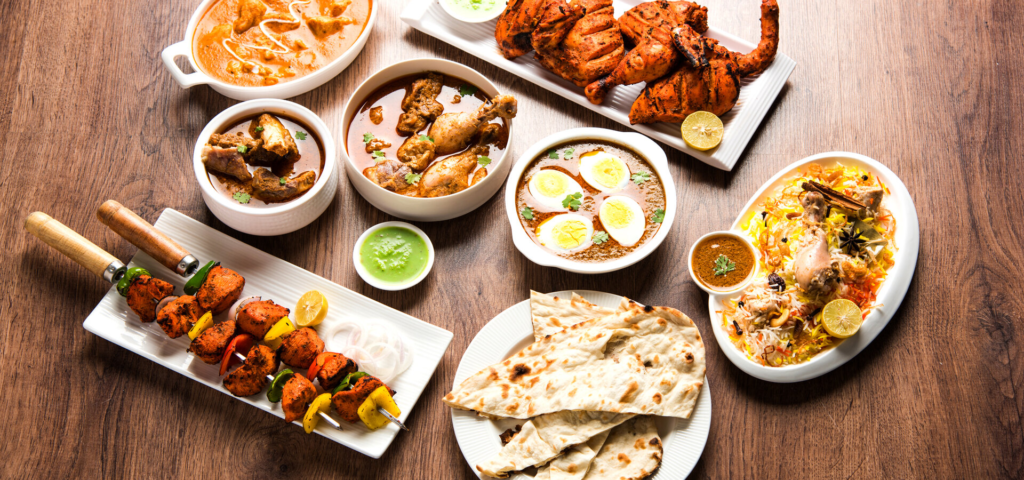
In Uttar Pradesh, the influence of Mughlai cuisine is seen in dishes like kebabs, biryani, and korma. Lucknow, the capital of Uttar Pradesh, is particularly famous for its Galouti Kebabs and Tunday Kebab, which are made with finely minced meat and a blend of aromatic spices. The Awadhi Biryani from the city of Lucknow is another famous dish, known for its fragrant rice and succulent pieces of meat, cooked in a dum (slow cooking) method.
Rogan Josh, Kebabs, Shami Kebab, and Korma are just a few of the Mughlai-inspired dishes that define the cuisine of Uttar Pradesh. Mughlai sweets such as Shahi Tukda (a bread pudding soaked in sugar syrup) and Kheer (a sweet rice pudding) are also popular in the state.
Awadhi Cuisine
Awadhi cuisine originates from the city of Lucknow and is renowned for its unique cooking techniques and rich, flavorful dishes. The cuisine is a perfect blend of vegetarian and non-vegetarian offerings, with an emphasis on slow cooking and marination. The dishes are often prepared with mild spices, allowing the natural flavors of the ingredients to shine through.
Some of the most famous dishes of Awadhi cuisine include Korma, Nihari, Lucknawi Biryani, Seekh Kebab, and Kachoris. Tunday Kebab, named after its creator, is a must-try delicacy, made from minced meat and cooked with a variety of spices. Lucknowi Biryani, cooked with long-grain basmati rice and meat, is a flavorful and aromatic dish that showcases the essence of Awadhi cooking.

Another significant feature of Awadhi cuisine is Pulao and Shami Kebabs, often served alongside Raita or salads. The use of yogurt and saffron adds depth and complexity to the flavors. Desserts like Zarda (a sweet rice dish) and Baklava also make their mark in Awadhi cuisine.
Bhojpuri Cuisine
Bhojpuri cuisine, which comes from the Bhojpur region near the Bihar border, reflects the simpler yet flavorful food traditions of the rural communities in Uttar Pradesh. Known for its mild spices, Bhojpuri cuisine is less hot than other North Indian cuisines. It incorporates a wide variety of vegetarian and non-vegetarian dishes.
In Bhojpuri cuisine, staples like roti (flatbread), dal (lentils), and sabzi (vegetable dishes) are common, often served with a side of chutney or pickles. Popular dishes include Litti Chokha, a traditional dish made of wheat flour dough stuffed with roasted gram flour and served with mashed vegetables like eggplant, tomato, and potatoes. Chana Ghugni (chickpeas cooked in a spicy curry) and Macher Jhol (fish curry) are also staple Bhojpuri dishes.

Bhojpuri cuisine uses fewer spices compared to the more robust Mughlai and Awadhi cuisines but focuses more on the use of ghee and mustard oil to enhance the flavors. Its flavors are considered comforting and home-style, making it a favorite in rural Uttar Pradesh.
Conclusion
The cuisine of Uttar Pradesh is a perfect reflection of its rich cultural diversity and history. Whether it’s the Mughlai grandeur of Lucknow, the Awadhi slow-cooked flavors, or the Bhojpuri simplicity of rural life, Uttar Pradesh offers a culinary experience that caters to all tastes. The state’s food is not just about meals but is a celebration of its cultural heritage and the historical influences that have shaped it over centuries.

